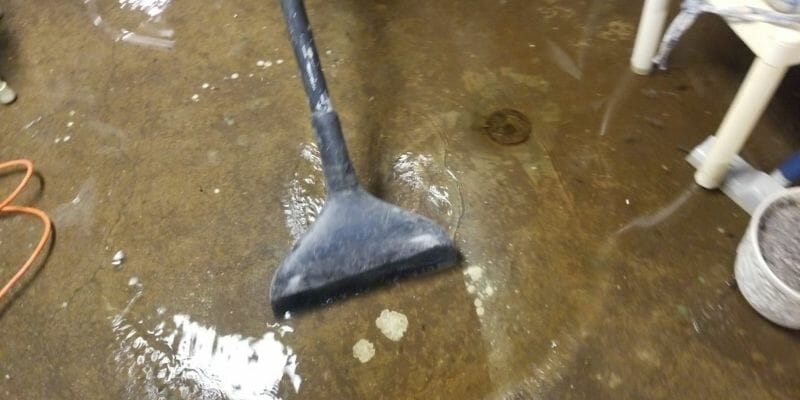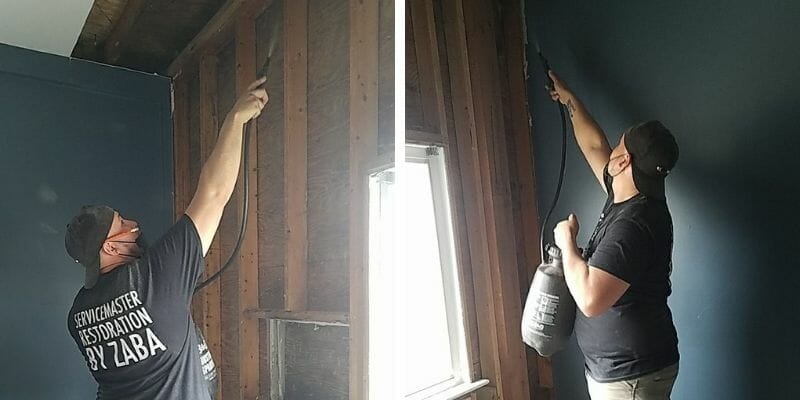It doesn’t take long to mop up a spill on the kitchen floor. If water splashes out of the tub, you throw down a couple of towels. These routines work great on small mishaps.
When you’re facing serious home water damage across multiple rooms, you need an action plan. You need to know what to do first and how to minimize your losses.
As Chicago’s leading water damage restoration company, we help homeowners deal with water damage every day. We want you to be prepared to take important steps as soon as you can. Preventative strategies make a big difference too. This complete guide to residential water damage covers it all.
Let’s dive in.
Home Water Damage: 10 Steps to Take Right Away
Fortunately, widespread water damage doesn’t happen as often as a wet floor in the kitchen or bath. When it does, the size of the problem seems overwhelming. You wonder where and how to start.
If you’re suddenly dealing with water damage in the house, knowing what to do makes a big difference. Follow these 10 steps for recovering your home and belongings as quickly as possible.
1. Identify and Fix the Problem

Locate the source of the water. If it’s a faulty line under the sink or behind the toilet, close the supply line valve. If it’s a leaking pipe, repair it with epoxy putty, pipe tape or a patch and clamp kit.
Power Tip: If you can’t pinpoint the problem, turn off your home’s main water supply, and call a licensed plumber.
2. Contact Your Insurance Company
In most cases, residential water damage is covered by homeowners insurance. Talk to your agent, and schedule an inspection to assess losses. Ask for the name of a certified water damage restoration business. You may need help with cleanup, repairs and reconstruction.
3. Document the Water Damage
Take pictures of all your affected belongings, including furniture, appliances, electronics and clothing. Document water-damaged walls, ceilings and floors. Keep all the photos in one digital file folder for sharing with your insurer.
4. Sort and Assess

Next, take a close look at the condition of personal belongings. You might be able to clean some lightly damaged items. If you’re not sure, ask a restoration company for help. Our technicians here at ServiceMaster by Zaba specialize in salvaging all types of flood and water-damaged belongings.
5. Get Off to a Safe Start
Start by protecting yourself from injuries and waterborne bacteria with solid working gear. Suit up in heavy rubber boots and long-cuff gloves. You may also want to shut off electricity to the affected areas.
6. Remove All Water

If you don’t have a shop vac, rent one at the home improvement center. It’s possible to mop up standing water, but a good wet vac quickly takes care of the job. Use heavy-duty extension cords to run the equipment in rooms where you’ve turned off the electricity.
Power Tip: Know when the vac canister is almost full by listening for sound changes in its motor.
7. Start the Drying Process
If possible, rent large air movers and dehumidifiers to speed up the drying process. Ordinary box fans work, but you want to circulate as much air volume as possible. Set up the equipment so that it creates crosscurrents through water-damaged areas. Let everything run 24/7 for at least three or four days.
8. Clean, Repair and Restore
Arm yourself with an assortment of disinfecting cleaners. Check product labels so that you’ll know which are safe for use on porous materials. Go over all surfaces, including walls, ceilings and floors. Follow up with repairs and restoration as needed for water-damaged drywall, ceilings and floors.
9. Be Aware of Mold Hazards

Mold mitigation is a critical part of home water damage restoration. Treat all affected surfaces with an antimicrobial product formulated to kill mold. You can use a bleach and water solution on most non-porous materials, but anti-fungal products are a safer choice.
10. Know When to Call the Pros
Repairing a home after water damage can become a big project. It also poses personal safety risks. Replacing a soggy ceiling involves heavy ladder work. Cleanup after a sewage spill exposes you to dangerous pathogens. If you have any doubts about doing it yourself, call a water damage restoration company.
Power Tip: Here at ServiceMaster by Zaba, our industry-certified technicians have the resources and equipment it takes to get big jobs done quickly and efficiently.
How Do You Deal With Water Damage From Storm Flooding?

Storm flooding can hit any time of year, but it’s become a spring ritual for many parts of the country, including Chicago. Natural flooding events leave behind unique water damage problems.
Floodwater is filled with all types of debris that complicates cleanup. It also carries hazardous chemical and organic contaminants. We recommend a two-pronged approach to dealing with the problem.
- Develop routines around the house that reduce the chances of home flooding during a natural event.
- Keep contact information for a certified restoration business handy in case of an emergency.
10 Signs of Home Water Damage

Sometimes, large water damage problems start out small. Given enough time, a tiny leak can ruin a ceiling or flood a basement. Stay on the lookout for these signs of trouble inside and outside the house.
1. Ring-like stains on ceilings may be caused by loose shingles or flashing problems on the roof.
2. Damp insulation in the attic is another a sign of water leaking through the roof.
3. Blistered paint and peeling paper often indicate water damage in the walls of your home.
4. Warped or loose baseboards are also signs of water damage hiding inside walls.
5. Soft spots in floors, especially around bathtubs, occur when plumbing fixtures fail.
6. Tile or laminated wood floors warp and crack when exposed to moisture for long periods of time.
7. Mold and watermarks under sinks may be the result of faulty supply lines or fixtures.
8. Persistent, musty smells can be signs of hidden water damage in the house.
9. Basement walls can stain and crack due to water accumulation around the foundation.
10. Clogged gutters often spill rain and debris down exterior walls, soaking window and door frames.
Does Home Insurance Cover Water Damage?
In most situations, homeowners insurance covers residential water damages. This includes small and large flood problems caused by frozen burst pipes, leaky plumbing and broken appliances.
Check with your agent for details about your coverage. Policies routinely pay for professional cleanup, water removal, water damage mitigation and property restoration. An experienced water damage contractor takes care of the work and also help you process the insurance claim.
It’s important to note that traditional homeowners policies don’t cover natural flood events. However, you can protect your house and belongings by purchasing flood insurance through the National Flood Insurance Program.
Dealing With Home Water Damage in Chicago? We Can Help!
There are situations that turn residential water damage restoration into a very big job. For example, structural material exposed to water for more than 24 hours needs to be torn out and replaced. Mold growth hiding deep inside walls requires specialized mitigation techniques.
When you’re facing more than you can handle, let us help. You can count on ServiceMaster by Zaba for the best residential water damage restoration services in Chicago and the Suburbs. We’re just a phone call away: 773-647-1985
The post 10 Important Steps to Take After Water Damage in Your Home appeared first on ServiceMaster Restoration by Zaba.
source https://www.servicemasterbyzaba.com/blog/home-water-damage/
No comments:
Post a Comment